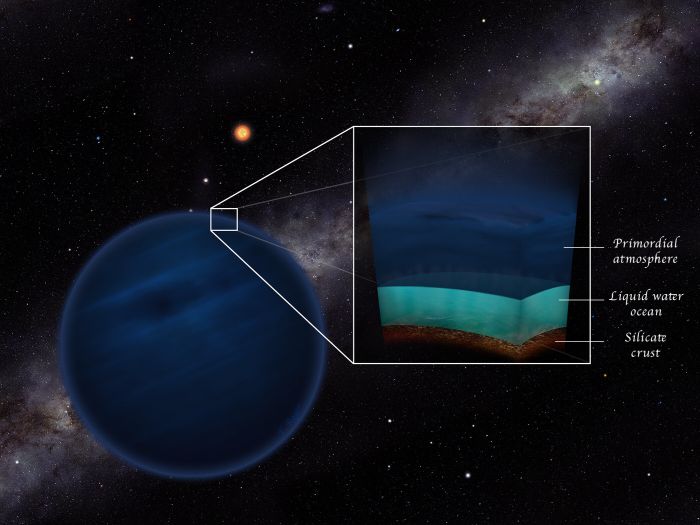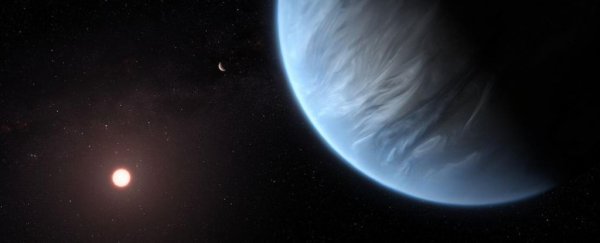Our blueprint for the habitability of exoplanets is just one world in the entire cosmos: Earth. Our home is the only planet on which we know, for a certainty, life has emerged.
But the conditions for life as we know it may not be restricted to Earth-like planets, and now scientists have determined one kind of exoplanet that might have habitable conditions for billions of years.
The key is in liquid water that sticks around long-term. Here on Earth, the presence of liquid water was vital for the emergence of life. By extension, exoplanets that may be able to retain liquid water could have a better chance of fostering life as we currently understand it.
New research, led by astronomer Marit Mol Lous of the University of Zürich in Switzerland, concludes that a nice, thick atmosphere of hydrogen and helium can sustain temperatures and conditions suitable for life for a very long time indeed.
"One of the reasons that water can be liquid on Earth is its atmosphere," says theoretical astrophysicist Ravit Helled of the University of Zurich in Switzerland.
"With its natural greenhouse effect, it traps just the right amount of heat to create the right conditions for oceans, rivers, and rain."
Earth's atmosphere didn't always look the way it does today, however. Now, it's mostly nitrogen, followed by oxygen, with only trace amounts of hydrogen and helium.
When the planet was newly formed, it had what is called a primordial atmosphere, consisting mostly of hydrogen and helium: the main constituents of the cloud of dust and gas from which the Sun and the Solar System formed.
Earth lost its primordial atmosphere pretty early on, likely as a result of several processes, including irradiation from a very hot young Sun, and meteorite bombardment.
But it's possible that a super-Earth exoplanet – one more massive than Earth, but less massive than Neptune – might be able to retain its primordial atmosphere for a lot longer than Earth did.
"Such massive primordial atmospheres can also induce a greenhouse effect – much like Earth's atmosphere today," Helled explains. "We therefore wanted to find out if these atmospheres can help to create the necessary conditions for liquid water."
To conduct this investigation, the team turned to simulations, modeling exoplanets with different core masses, atmosphere masses, and orbital distances from their host stars, which the team modeled as Sun-like.
Their results showed that exoplanets with a thick primordial atmosphere could indeed be warm enough to maintain the presence of liquid water for up to 10 billion years.
 This is how one of these exoplanets might look. (Thibaut Roger/Universität Bern/Universität Zürich)
This is how one of these exoplanets might look. (Thibaut Roger/Universität Bern/Universität Zürich)
But there are caveats. To avoid the intense stellar radiation that can strip a primordial atmosphere, the exoplanet needs to be quite a distance from the star – around twice Earth's distance from the Sun. For the Solar System, that is so far from the Sun that any water on a planet's surface is likely to be frozen.
But the Sun isn't the only source of heating a planet may enjoy; some worlds, Earth included, can generate their own heat. This can be by a number of pathways, such as geothermal processes, and the presence of radioactive elements that generate heat as they decay.
So, if a super-Earth exoplanet at that distance from its host star had both a primordial atmosphere and sufficient internal heating to keep itself warm, then the conditions for liquid water at the surface would be met, the researchers said.
"To many, this may come as a surprise," says theoretical astrophysicist Christoph Mordasini of the University of Bern.
"Astronomers typically expect liquid water to occur in regions around stars that receive just the right amount of radiation: not too much, so that the water does not evaporate, and not too little, so that it does not all freeze.
"Since the availability of liquid water is a likely prerequisite for life, and life probably took many millions of years to emerge on Earth, this could greatly expand the horizon for the search for alien lifeforms. Based on our results, it could even emerge on so-called free-floating planets that do not orbit around a star."
This internal heating model could hypothetically support life on worlds with thick icy shells, such as Saturn's moon Enceladus and Jupiter's moon Europa, and moons orbiting rogue exoplanets drifting unmoored throughout the galaxy.
For the team's model, it requires a lot of pieces being in exactly the right place at the right time. That's not impossible – after all, Earth exists, and so does all the life on it – but it may not happen readily.
"While our results are exciting, they should be considered with a grain of salt. For such planets to have liquid water for a long time, they have to have the right amount of atmosphere. We do not know how common that is," Mordasini says.
"And even under the right conditions, it is unclear how likely it is for life to emerge in such an exotic potential habitat. That is a question for astrobiologists. Still, with our work we showed that our Earth-centered idea of a life-friendly planet might be too narrow."
The research has been published in Nature Astronomy.
